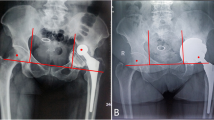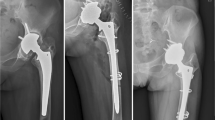Abstract
Purpose
Reconstruction of severe acetabular deficiency is extremely challenging in total hip arthroplasty (THA) revisions. Novel bispherical augments were designed to fill acetabular bone loss and facilitate restoration of hip center of rotation (HCOR). Current study aims to compare the outcomes of bispherical augments and tantalum augments.
Methods
Between July 2017 and December 2018, bispherical augments (BA group) were implanted in 25 patients (25 hips) and 22 patients (22 hips) underwent porous tantalum augments (TA group) reconstruction in revision THA. Clinical and radiographic results were evaluated for 25 hips in BA group and 20 hips in TA group at the final follow-up. The mean duration of follow-up was 2.9 years (range, 2.2 ~ 3.7) in BA group and 2.9 years (range, 2.3 ~ 3.8) in TA group.
Results
Harris hip scores, HCOR, and leg length discrepancy (LLD) correction did not differ between the treatment groups. The bispherical augments were located more closer to the medial-superior part (zone II) of acetabular shell while the majority of tantalum augments were located at the lateral-superior part (zone I) (P = 0.010). More screws were used in the BA group for augment fixation (mean 2.1 vs. 1.3) (P = 0.000). There was no evidence of loosening or migration in all hips. Only one dislocation occurred in BA group and treated with closed reduction, no recurrence of instability up to the final follow-up.
Conclusion
The clinical and radiological outcomes of bispherical augments were comparable with tantalum augments; this technique was a reliable alternative method in severe acetabular deficiency reconstruction.




Similar content being viewed by others
References
Sloan M, Premkumar A, Sheth NP (2018) Projected volume of primary total joint arthroplasty in the U.S., 2014 to 2030. J Bone Joint Surg Am 100:1455–1460. https://doi.org/10.2106/JBJS.17.01617
Schwartz AM, Farley KX, Guild GN, Bradbury TL Jr (2020) Projections and epidemiology of revision hip and knee arthroplasty in the United States to 2030. J Arthroplasty 35:S79–S85. https://doi.org/10.1016/j.arth.2020.02.030
Mäkinen TJ, Abolghasemian M, Watts E, Fichman SG, Kuzyk P, Safir OA, Gross AE (2017) Management of massive acetabular bone defects in revision arthroplasty of the hip using a reconstruction cage and porous metal augment. Bone Joint J 99-B:607–613. https://doi.org/10.1302/0301-620X.99B5
Sculco PK, Ledford CK, Hanssen AD, Abdel MP, Lewallen DG (2017) The evolution of the cup-cage technique for major acetabular defects: full and half cup-cage reconstruction. J Bone Joint Surg Am 99:1104–1110. https://doi.org/10.2106/JBJS.16.00821
Baauw M, van Hooff ML, Spruit M (2016) Current construct options for revision of large acetabular defects: a systematic review. JBJS Rev 4:1–11. https://doi.org/10.2106/JBJS.RVW.15.00119
Nehme A, Lewallen DG, Hanssen AD (2004) Modular porous metal augments for treatment of severe acetabular bone loss during revision hip arthroplasty. Clin Orthop Relat Res 429:201–208. https://doi.org/10.1097/01.blo.0000150133.88271.80
Whitehouse MR, Masri BA, Duncan CP, Garbuz DS (2015) Continued good results with modular trabecular metal augments for acetabular defects in hip arthroplasty at 7 to 11 years. Clin Orthop Relat Res 473:521–527. https://doi.org/10.1007/s11999-014-3861-x
Jenkins DR, Odland AN, Sierra RJ, Hanssen AD, Lewallen DG (2017) Minimum five-year outcomes with porous tantalum acetabular cup and augment construct in complex revision total hip arthroplasty. J Bone Joint Surg Am 99:e49. https://doi.org/10.2106/JBJS.16.00125
Ling TX, Li JL, Zhou K, Xiao Q, Pei FX, Zhou ZK (2018) The use of porous tantalum augments for the reconstruction of acetabular defect in primary total hip arthroplasty. J Arthroplasty 33:453–459. https://doi.org/10.1016/j.arth.2017.09.030
O’Neill CJ, Creedon SB, Brennan SA, O’Mahony FJ, Lynham RS, Guerin S, Gul R, Harty JA (2018) Acetabular revision using trabecular metal augments for paprosky type 3 defects. J Arthroplasty 33:823–828. https://doi.org/10.1016/j.arth.2017.10.031
Löchel J, Janz V, Hipfl C, Perka C, Wassilew GI (2019) Reconstruction of acetabular defects with porous tantalum shells and augments in revision total hip arthroplasty at ten year follow up. Bone Joint J 101-B:311–316. https://doi.org/10.1302/0301-620X.101B3
Webb JE, McGill RJ, Palumbo BT, Moschetti WE, Estok DM (2017) The double-cup construct: a novel treatment strategy for the management of paprosky IIIA and IIIB acetabular defects. J Arthroplasty 32:S225–S231. https://doi.org/10.1016/j.arth.2017.04.017
Paprosky WG, Perona PG, Lawrence JM (1994) Acetabular defect classification and surgical reconstruction in revision arthroplasty. A 6-year follow-up evaluation. J Arthroplasty 9:33–44
Hao Y, Wang L, Jiang W, Wu W, Ai S, Shen L, Zhao S, Dai K (2020) 3D printing hip prostheses offer accurate reconstruction, stable fixation, and functional recovery for revision total hip arthroplasty with complex acetabular bone defect. Engineering 6:1285–1290. https://doi.org/10.1016/j.eng.2020.04.013
DeLee JG, Charnley J (1976) Radiological demarcation of cemented sockets in total hip replacement. Clin Orthop Relat Res 121:20–32
Schierjott RA, Hettich G, Graichen H, Jansson V, Rudert M, Traina F, Weber P, Grupp TM (2019) Quantitative assessment of acetabular bone defects: a study of 50 computed tomography data sets. PLoS ONE 14:e0222511. https://doi.org/10.1371/journal.pone.0222511
Bobyn JD, Stackpool GJ, Hacking SA, Tanzer M, Krygier JJ (1999) Characteristics of bone ingrowth and interface mechanics of a new porous tantalum biomaterial. J Bone Joint Surg Br 81B:907–914. https://doi.org/10.1302/0301-620x.81b5.9283
Li G, Wang L, Pan W, Yang F, Jiang W, Wu X, Kong X, Dai K, Hao Y (2016) In vitro and in vivo study of additive manufactured porous Ti6Al4V scaffolds for repairing bone defects. Sci Rep 6:34072. https://doi.org/10.1038/srep34072
Taniguchi N, Fujibayashi S, Takemoto M, Sasaki K, Otsuki B, Nakamura T, Matsushita T, Kokubo T, Matsuda S (2016) Effect of pore size on bone ingrowth into porous titanium implants fabricated by additive manufacturing: an in vivo experiment. Mater Sci Eng C Mater Biol Appl 59:690–701. https://doi.org/10.1016/j.msec.2015.10.069
Castagnini F, Bordini B, Stea S, Calderoni PP, Masetti C, Busanelli L (2019) Highly porous titanium cup in cementless total hip arthroplasty: registry results at eight years. Int Orthop 43:1815–1821. https://doi.org/10.1007/s00264-018-4102-9
Beckmann NA, Bitsch RG, Gondan M, Schonhoff M, Jaeger S (2018) Comparison of the stability of three fixation techniques between porous metal acetabular components and augments. Bone Joint Res 7:282–288. https://doi.org/10.1302/2046-3758.74.BJR-2017-0198.R1
Sporer SM, O’rourke M, Chong P, Paprosky WG (2005) The use of structural distal femoral allografts for acetabular reconstruction. Average ten-year follow-up. J Bone Joint Surg Am 87:760–765
Sporer SM, O’rourke M, Chong P, Paprosky WG (2006) The use of structural distal femoral allografts for acetabular reconstruction. Surgical technique. J Bone Joint Surg Am 88-A:92–99
Brown NM, Morrison J, Sporer SM, Paprosky WG (2016) The use of structural distal femoral allograft for acetabular reconstruction of paprosky type IIIA defects at a mean 21 years of follow-up. J Arthroplasty 31:680–683. https://doi.org/10.1016/j.arth.2015.10.020
Lachiewicz PF, Soileau ES (2013) Fixation, survival, and dislocation of jumbo acetabular components in revision hip arthroplasty. J Bone Joint Surg Am 95:543–548. https://doi.org/10.2106/JBJS.L.00758
Blumenfeld TJ, Bargar WL (2012) Surgical technique: a cup-in-cup technique to restore offset in severe protrusio acetabular defects. Clin Orthop Relat Res 470:435–441. https://doi.org/10.1007/s11999-011-2075-8
Chiarlone F, Cavagnaro L, Zanirato A, Alessio Mazzola M, Lovisolo S, Mosconi L, Felli L, Burastero G (2020) Cup-on-cup technique: a reliable management solution for severe acetabular bone loss in revision total hip replacement. Hip Int 30:12–18. https://doi.org/10.1177/1120700020926932
Funding
This work was supported by the National Natural Science Foundation of China (81902201, 82072408), the Scientific Research Fund of Academic and Technical Leaders of Anhui Province (2020D259), and the Fundamental Research Funds for the Central Universities (WK9110000093).
Author information
Authors and Affiliations
Contributions
All authors contributed to the study conception and design. Material preparation, data collection and analysis were performed by Guoyuan Li, Xiaoqi Zhang, Min Chen, and Zhengliang Luo. Operations were performed by Xiaofeng Ji and Xifu Shang. The first draft of the manuscript was written by Guoyuan Li and all authors commented on previous versions of the manuscript. All authors read and approved the final manuscript. The first two authors contributed equally to this manuscript.
Corresponding author
Ethics declarations
Conflict of interest
The authors declare no competing interests.
Ethics approval
Approval was obtained from the ethics committee of The First Affiliated Hospital of University of Science and Technology of China. The procedures used in this study adhere to the tenets of the Declaration of Helsinki.
Consent to participate
Informed consent was obtained from all individual participants included in the study.
Consent for publication
Patients signed informed consent regarding publishing their data and photographs.
Additional information
Publisher’s note
Springer Nature remains neutral with regard to jurisdictional claims in published maps and institutional affiliations.
Rights and permissions
About this article
Cite this article
Li, Gy., Zhang, Xq., Chen, M. et al. Modular revision strategy with bispherical augments in severe acetabular deficiency reconstruction. International Orthopaedics (SICOT) 46, 215–222 (2022). https://doi.org/10.1007/s00264-021-05195-y
Received:
Accepted:
Published:
Issue Date:
DOI: https://doi.org/10.1007/s00264-021-05195-y




